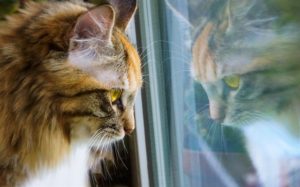Human-Companion Animal Loss in the COVID Era
 This is the third time, I’ve addressed the subject of human loss and the companion animal bond in my commentaries. I first wrote about it during this website’s inaugural year, 2002. Back then I wrote about this subject as it related to dogs and cats. following the upheaval of the 9/11 attacks.
This is the third time, I’ve addressed the subject of human loss and the companion animal bond in my commentaries. I first wrote about it during this website’s inaugural year, 2002. Back then I wrote about this subject as it related to dogs and cats. following the upheaval of the 9/11 attacks.
By the time I updated and reprinted it in 2019, the human-companion animal bond had become even more symbolic. Once again, I wanted to know why this was happening: what was driving this change in the human-canine and -feline bonds? At that time, I came to the conclusion that this human emotional and intellectual distancing made it easier not to think about what would become of these animals if something happened to their people. How would the bonds these people and their caregivers formed with these animals change after the owners were gone?
Yet again, I believed I’d addressed all the issues… Until COVID and its attendant political and civil unrest created a situation in which human loss took other forms in addition to death. Unlike past human-animal bond changes in our society, these involve millions of people worldwide facing an unprecedented phenomenon that leave many floundering to find meaningful reference points. It exposed flaws in healthcare systems. It tested friendships to the limits. But worst of all, it cut off dying patients from supportive human family members and friends at a time they needed these people the most.
attendant political and civil unrest created a situation in which human loss took other forms in addition to death. Unlike past human-animal bond changes in our society, these involve millions of people worldwide facing an unprecedented phenomenon that leave many floundering to find meaningful reference points. It exposed flaws in healthcare systems. It tested friendships to the limits. But worst of all, it cut off dying patients from supportive human family members and friends at a time they needed these people the most.
Is it any wonder so many people either turned to the animals in their households or went out and got animals specifically so they could turn to them for comfort them during this time? Not surprisingly, those who turned to resident cats and dogs with whom they had established relationships comfort often fared better than those who took the rescue route. This occurred because animals from the latter sources may arrive with little reliable history that would help predict the likelihood of the animal’s success in a new physical, mental, and bond environment. Although some people do see sorting out and resolving (as much as possible) any health or behavioral problems associated with the animal’s transition to a new, often quite different environment as a fulfilling way to fill their empty hours, the disconnect between their expectations of their new pets and reality may make others more depressed.
People who already live with a canine or feline resident are more likely to be familiar with any behavioral or medical issues their animals have. They either already accept or know how to address these. And they also realize that any treatment the animals require or may require was and is worth it because of the comfort these animals presence gives them and their families in these difficult times. Other people reduced to communicating remotely with ill human loved ones with whom they only can communicate remotely often discovered that pictures of the family cat or dog help fill the voids that occur in telecommunication when words fail.
Altogether these changes have added a surreal quality to what’s was and is still going on in some households. Further enhancing this effect were those facing potential end-of-life decisions who simultaneously had to consider the welfare of their animals should they no longer be there to care for them. More often than not, this isn’t something the human medical community thinks about, even though some of their patients may. A lot. Even more than their own well-being.
Another group of people may be so absorbed in their own problems that they don’t give a thought to what will become to any companion animals if they no longer can take care of them, let alone die. If the bond between the animal and the person is as weak as that between the person and the animal and the animal is healthy and well-behaved, then successfully rehoming the animal is a real possibility. If not, then the animal’s future may be more uncertain.
they don’t give a thought to what will become to any companion animals if they no longer can take care of them, let alone die. If the bond between the animal and the person is as weak as that between the person and the animal and the animal is healthy and well-behaved, then successfully rehoming the animal is a real possibility. If not, then the animal’s future may be more uncertain.
A less dramatic form of owner loss may occur as more people become vaccinated and spend more time away from home. While not as final a departure as the permanent loss of the owner due to disease or injury, these intermittent losses of a once dedicated owner may be more stressful for some animals. Unlike death, the owner’s absence in these cases isn’t permanent. Often may not be predictable either. For some animals who have lived with a doting person during the COVID era, the results of the intermittent losses of the person’s presence may be quite traumatic.
For cats and dogs who were adopted from shelters specifically to provide comfort for their people, the human relationship with the animal may have been a highly active and human-reactive one when all they had for companionship was each other. Unless the owner took the time to acclimatize the animal to gradually longer periods of being alone before any new away-from-home human activity shift occurred, the period of adjustment for the animal could be lengthy. And if the animal dissipates any stress being alone generates by chewing or marking owner furnishings or other belongings, this may undermine the relationship between the person and the once-loved animal.
No doubt you can think of other situations of canine or feline responses when owner loss occurs forever or even just intermittently. As always, recognize that such a possibility is real. That way when and if it happens, the parting will be one of sweet sorrow and not one of regrets.
Human-Companion Animal Loss in the COVID Era
By the time I updated and reprinted it in 2019, the human-companion animal bond had become even more symbolic. Once again, I wanted to know why this was happening: what was driving this change in the human-canine and -feline bonds? At that time, I came to the conclusion that this human emotional and intellectual distancing made it easier not to think about what would become of these animals if something happened to their people. How would the bonds these people and their caregivers formed with these animals change after the owners were gone?
Yet again, I believed I’d addressed all the issues… Until COVID and its attendant political and civil unrest created a situation in which human loss took other forms in addition to death. Unlike past human-animal bond changes in our society, these involve millions of people worldwide facing an unprecedented phenomenon that leave many floundering to find meaningful reference points. It exposed flaws in healthcare systems. It tested friendships to the limits. But worst of all, it cut off dying patients from supportive human family members and friends at a time they needed these people the most.
attendant political and civil unrest created a situation in which human loss took other forms in addition to death. Unlike past human-animal bond changes in our society, these involve millions of people worldwide facing an unprecedented phenomenon that leave many floundering to find meaningful reference points. It exposed flaws in healthcare systems. It tested friendships to the limits. But worst of all, it cut off dying patients from supportive human family members and friends at a time they needed these people the most.
Is it any wonder so many people either turned to the animals in their households or went out and got animals specifically so they could turn to them for comfort them during this time? Not surprisingly, those who turned to resident cats and dogs with whom they had established relationships comfort often fared better than those who took the rescue route. This occurred because animals from the latter sources may arrive with little reliable history that would help predict the likelihood of the animal’s success in a new physical, mental, and bond environment. Although some people do see sorting out and resolving (as much as possible) any health or behavioral problems associated with the animal’s transition to a new, often quite different environment as a fulfilling way to fill their empty hours, the disconnect between their expectations of their new pets and reality may make others more depressed.
People who already live with a canine or feline resident are more likely to be familiar with any behavioral or medical issues their animals have. They either already accept or know how to address these. And they also realize that any treatment the animals require or may require was and is worth it because of the comfort these animals presence gives them and their families in these difficult times. Other people reduced to communicating remotely with ill human loved ones with whom they only can communicate remotely often discovered that pictures of the family cat or dog help fill the voids that occur in telecommunication when words fail.
Altogether these changes have added a surreal quality to what’s was and is still going on in some households. Further enhancing this effect were those facing potential end-of-life decisions who simultaneously had to consider the welfare of their animals should they no longer be there to care for them. More often than not, this isn’t something the human medical community thinks about, even though some of their patients may. A lot. Even more than their own well-being.
Another group of people may be so absorbed in their own problems that they don’t give a thought to what will become to any companion animals if they no longer can take care of them, let alone die. If the bond between the animal and the person is as weak as that between the person and the animal and the animal is healthy and well-behaved, then successfully rehoming the animal is a real possibility. If not, then the animal’s future may be more uncertain.
they don’t give a thought to what will become to any companion animals if they no longer can take care of them, let alone die. If the bond between the animal and the person is as weak as that between the person and the animal and the animal is healthy and well-behaved, then successfully rehoming the animal is a real possibility. If not, then the animal’s future may be more uncertain.
A less dramatic form of owner loss may occur as more people become vaccinated and spend more time away from home. While not as final a departure as the permanent loss of the owner due to disease or injury, these intermittent losses of a once dedicated owner may be more stressful for some animals. Unlike death, the owner’s absence in these cases isn’t permanent. Often may not be predictable either. For some animals who have lived with a doting person during the COVID era, the results of the intermittent losses of the person’s presence may be quite traumatic.
For cats and dogs who were adopted from shelters specifically to provide comfort for their people, the human relationship with the animal may have been a highly active and human-reactive one when all they had for companionship was each other. Unless the owner took the time to acclimatize the animal to gradually longer periods of being alone before any new away-from-home human activity shift occurred, the period of adjustment for the animal could be lengthy. And if the animal dissipates any stress being alone generates by chewing or marking owner furnishings or other belongings, this may undermine the relationship between the person and the once-loved animal.
No doubt you can think of other situations of canine or feline responses when owner loss occurs forever or even just intermittently. As always, recognize that such a possibility is real. That way when and if it happens, the parting will be one of sweet sorrow and not one of regrets.